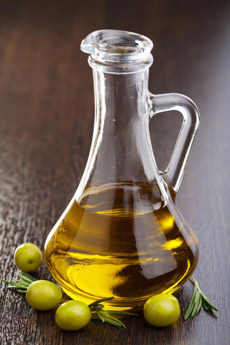TIP OF THE DAY: 10 Things To Do With Extra Herbs
|
There’s nothing better than fresh herbs to add flavor to your cooking—and herbs are virtually calorie-free. They enable you can use less salt, too.
Beyond what is called for in recipes, we add them to every meal of the day, from breakfast eggs and grits to salads (snip fresh herbs onto the greens or into egg salad, tuna salad, etc.), to yogurt (including dips and salad dressings) to grains and potatoes. You’d be surprised how much better your favorite sandwich or burger tastes with fresh basil leaves, chives and/or other favorite herbs. We grow a pot of basil, our favorite go-to herb, on the kitchen windowsill. But what if you end up with more herbs than you can use before they fade? Here are 10 of our favorite ways to use those extra herbs. EVERYDAY COOKING 1. Infuse honey, maple syrup, salad oil, vinegar. If you have more than one herb on hand, you can mixed them. |
Add rosemary, basil or whatever you’ve got to olive oil or other cooking oil. Photo courtesy FlavorYourLife.com. |
|
|
Use your freshly herbed condiments on salads, as a bread dip, on pasta and rice, etc. Consider homemade basil honey, tarragon vinegar and rosemary oil. NOTE: Use these infused condiments within five days (put a “use by” label on the jar) because bacteria can multiply. Commercial infused oils sterilize the herbs to prevent this. 2. Make herb butter. Stir chopped herbs into softened butter. You can keep it in the fridge for several weeks to enjoy as a bread spread and for cooking. Or freeze the butter for future use. One trick is to place the butter in plastic wrap and roll into a sausage shape. Freeze until it starts to firm; then cut into tablespoon-size slices and return to the freezer. Remove slices for as you need them for sauteéeing, to melt atop potatoes, rice and vegetables, etc. Herb butter is one type of compound butter. Check out these compound butter recipes. 3. Amp up conventional condiments. Add chopped herbs to mayonnaise for a more flavorful sandwich spread. Similarly, add them to ketchup and mustard. 4. Make herb ice cubes for cooking. Add the herbs to an ice cube tray and fill the tray with olive oil, stock or white wine. They’ll be at the ready to pop into sauces, soups, stews, stir-frys, etc. 5. Make pesto. Basil is a traditional pesto base, but anything can be made into pesto, and you can blend different herbs, along with arugula or spinach. Store the pesto topped with a thin layer of olive oil, in an airtight jar; it will keep for months. Homemade pesto recipe. |
||
 The old-fashioned way to dry herbs. Photo © Michaela | The Gardener’s Eden. |
BEVERAGES
6. Make herb ice cubes for drinks. Add herbs, chopped as finely or coarsely as you like, to the compartments of an ice cube tray and fill with water. Once frozen, you can pop them out and store them in a freezer bag. 7. Infuse vodka or other spirit. While there are endless fruit-flavored vodkas on the market, delicious herb- and spice-infused vodkas, which are popular in Russia, haven’t taken off with American consumers. Toss your herbs into a bottle of vodka and enjoy the infused vodka in shots or savory cocktails, like Bloody Marys and Martinis. Infuse chiles, cilantro, rosemary, sage, thyme: The alcohol kills bacteria growth, so you don’t have to remove the herbs (just be sure they are completely covered by the spirit when you infuse them). |
|
|
The method is easy: Crush the herbs in your hand to help release the oils and add the herbs to a bottle of vodka (you’ll have to consume some of the vodka if the bottle is full). Don’t use a bargain brand: The higher the quality of the vodka, the smoother and more flavorful the infusion. Place the bottle in a dark place and infuse for at least three days and up to two weeks. Look at other alcohol-herb pairings: bourbon with mint or basil, Limoncello with thyme or whatever inspires you. BAKING 8. Add to breads, muffins and biscuits. Chop the herbs finely, and don’t hesitate to combine fresh or dried fruit with the herbs. Our favorite combinations: blueberry-rosemary muffins and cheddar chive muffins. 9. Make pie crusts. From quiche to fruit pie, a little basil, thyme or rosemary in the crust can be a most welcome surprise. Use sweeter herbs with fruit pies. For savory pies, add whatever herbs appeal to you: chives, dill, oregano, etc. 10. Dehydrate the herbs. You don’t need an electric dehydrator. The photo above shows what everyone did in the days before dehydrators: Tie the stems with a string (or elastic band) and hang upside down to dry for a few days. You can hang the bunches on pegs, on a makeshift string or rope line, even clothespin-clipped to a hanger. When dry, remove the stems and store in an airtight container. If you like, you can grind them with a mortar and pestle before storing. What’s your favorite way to use extra herbs? Let us know.
|
||



